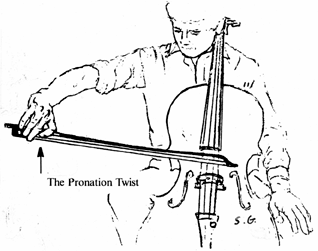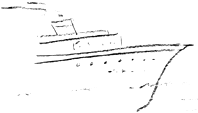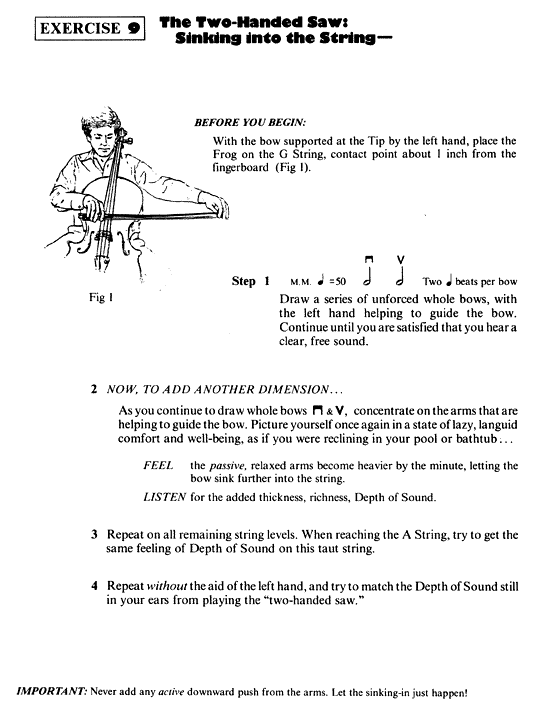| The Teaching Studio |
||
|
|||
| HW: Well, first of all, would you improvise a few expressive notes
or, perhaps, play the first phrase of the Dvorâk Concerto slow movement:  HW: Thank you! You certainly project much musicality in your playing and your pitch is excellent. As to Tone, that is, of course, a vast subject, but one or two points could be made now. Tell me, how do you produce a tone on the cello? STU: That's easy: the bow makes contact with a string and moves side to side. HW: Show me! HW: Good! But let me be more specific: your bow hair "caught" the string to free its vibrations and then moved back and forth parallel to the bridge. Now, what would you have to do to achieve a richer, thicker sound? STU: You'd have to press more with the bow. HW: Again, show me what you would do! |
|||
HW: This is where I can help you. First of all, there were visible signs of tension as you were trying to use pressure to achieve a fuller sound. You were doing what I call "The Pronation Twist", twisting (pronating) your forearm and raising your elbow and shoulder to force greater contact with the string. Unfortunately the sound matched your contortions. To be blunt, it became strident and almost choked. |
||
 How do you achieve this Depth of Sound? Your passive, buoyant arm must enable the bow to sink spring-like into the string, even as the bow travels its straight course parallel to the bridge. Let me show you a simple exercise from The Joy of Cello Playing, Master Lesson 4, to illustrate this point: |
||
 |
| NOW Bravo! Your tone is already richer and more resonant. Gone is that pressed, pinched sound. As you practice, picture yourself floating in a pool, with your passive, lazy arms buoyant in the water . . . . There are many more ideas on Tone Technique in my Master Lessons 4 & 5 of The Joy of Cello Playing Books. ___________________ Would you like to continue the Studio Tour?  or If you found this imaginary lesson helpful, Home Friendly Links |
| This site created and maintained by Harry Wimmer (hwimmer@wimmercello.com). Thanks to Shirley Givens (sgivens@peabody.jhu.edu) for her imaginative illustrations. Thanks to Kevin Wimmer (kwimmer@aol.com) for his selfless and expert assistance. |
| Design and content ©1999-2006 by Harry Wimmer. Artwork ©1999
by Shirley Givens. All materials on this website are limited to personal, non-commercial use. |